Is the digital piano for a child, adult beginner, or for an advanced player? Failing to choose a suitable instrument can have vast negative effects, so we shall not underestimate this essential question.
Digital piano for children
Children aged 3 to 5
Music has an exceedingly positive effect on children. It can banish boredom, and regular playing on a musical instrument develops perfectly the children's concentration and fine motor skills. Scientists agree that playing an instrument not only promotes the growth of intellect in children, but also improves memory. In addition, music shapes children's patience, perseverance and discipline.
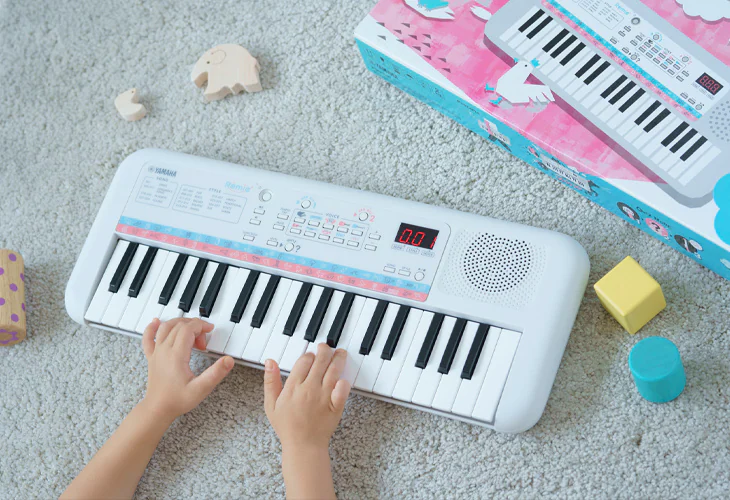 Yamaha PSS-E30 is the keyboard for the youngest with 37 mini keys, 30 tracks, headphone output and a fun quiz mode in which the child guesses the right sound or note.
Yamaha PSS-E30 is the keyboard for the youngest with 37 mini keys, 30 tracks, headphone output and a fun quiz mode in which the child guesses the right sound or note.
It is said that it is never too late to learn to play the piano. But at what age should you start so that it is not too early? Opinions of experts on this topic vary, but at the age of 3 to 5, the child is already mature enough to embark on a curious journey into the world of music.
At this age, it would be still too early for a serious digital piano, but children can make their first entertaining contact with the keys on one of children's piano. They are almost indestructible, have a wide repertoire of fun sounds and a reduced keyboard adapted to children's fingers.
Children aged 6 to 9
In most cases, children aged 6 to 9 are mature enough to start learning to play the piano seriously. They can keep focused longer and understand the basic context of melody and rhythm without much difficulty. Playing the piano at this age is a suitable relaxation activity in addition to the first homework.
If we want children to make real progress in playing the instrument and to stick with it, they should be entrusted to a skilled music teacher or enrolled in a music school.
The most common equipment of music schools is an acoustic upright piano. A digital piano is more suitable for exercising at home. It does not take up so much space, looks better and allows you to play with headphones plugged in.
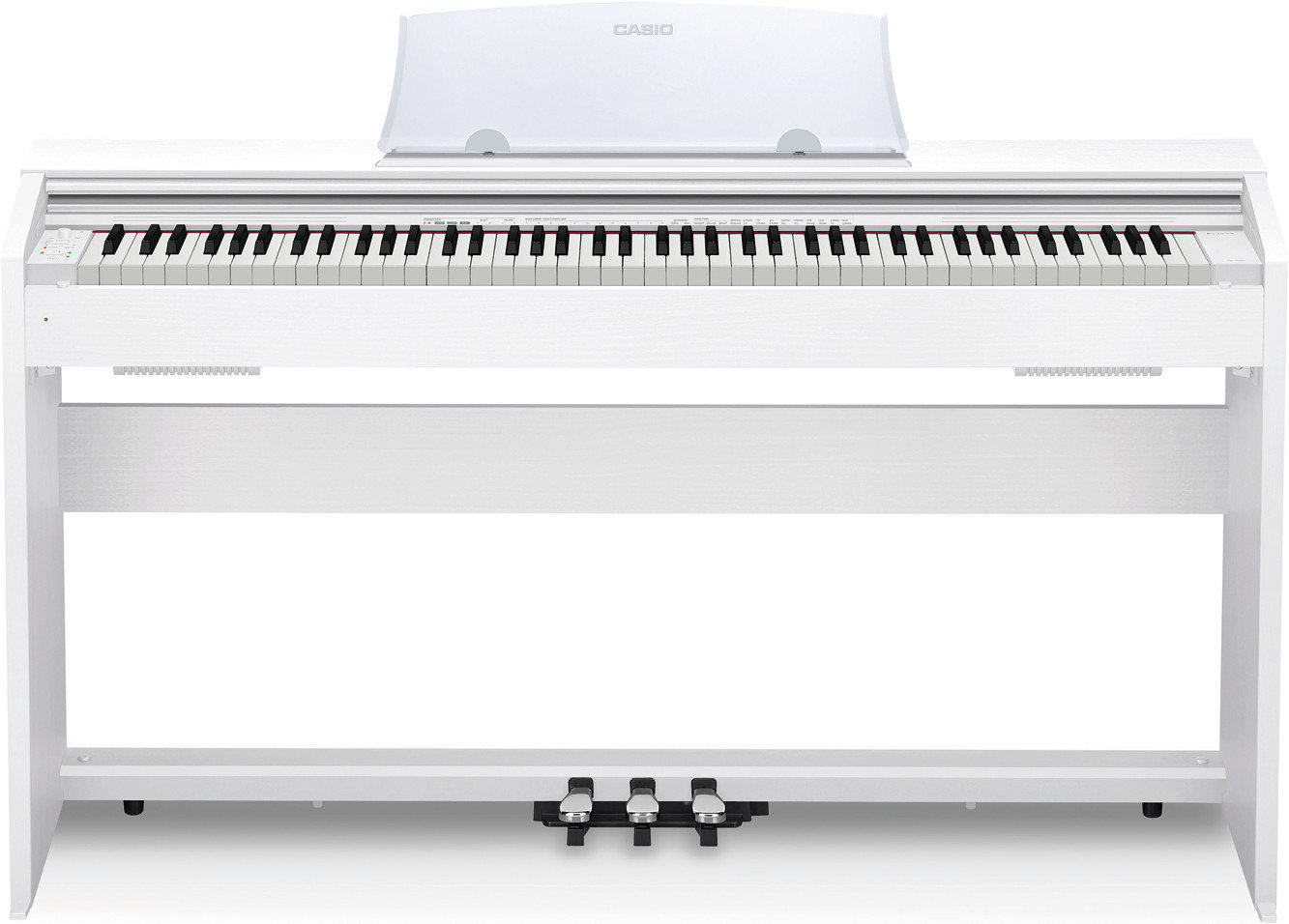
Casio PX 770 WE: slim modern design, natural feel while playing and Duet Mode that can divide the keyboard into two ranges, allowing the teacher and student to play at the same time.
An electric piano for children should resemble the sound and playing experience of an acoustic piano as closely as possible. You need to reach for models that have a balanced hammer-action mechanism and dynamic keys. An 88-key piano with built-in speakers, headphone output, and at least 64-note polyphony should be the norm.
Children aged 10 to 15
The most realistic sound and playing experience comparable to an acoustic piano should also be provided to children of age 10 to 15. A quality training program can also be a benefit at this age. More ambitious models even allow you to watch detailed notation on the prime piano display and point out any errors.
To maintain the proper tempo of the song, the metronome is being used. A beginner should use it until he/she acquires a natural ability to keep the pace.
The mechanical metronome is an elegant piano accessory, but nowadays, it is fully replaced by a practical and easy-to-use metronome built into the body of the digital piano. Therefore, let us focus on choosing a piano with a balanced hammer-action mechanism, teaching software and metronome.
The standard model suitable for pianists who are 10 years old and older should be equipped with at least 128-note polyphony.
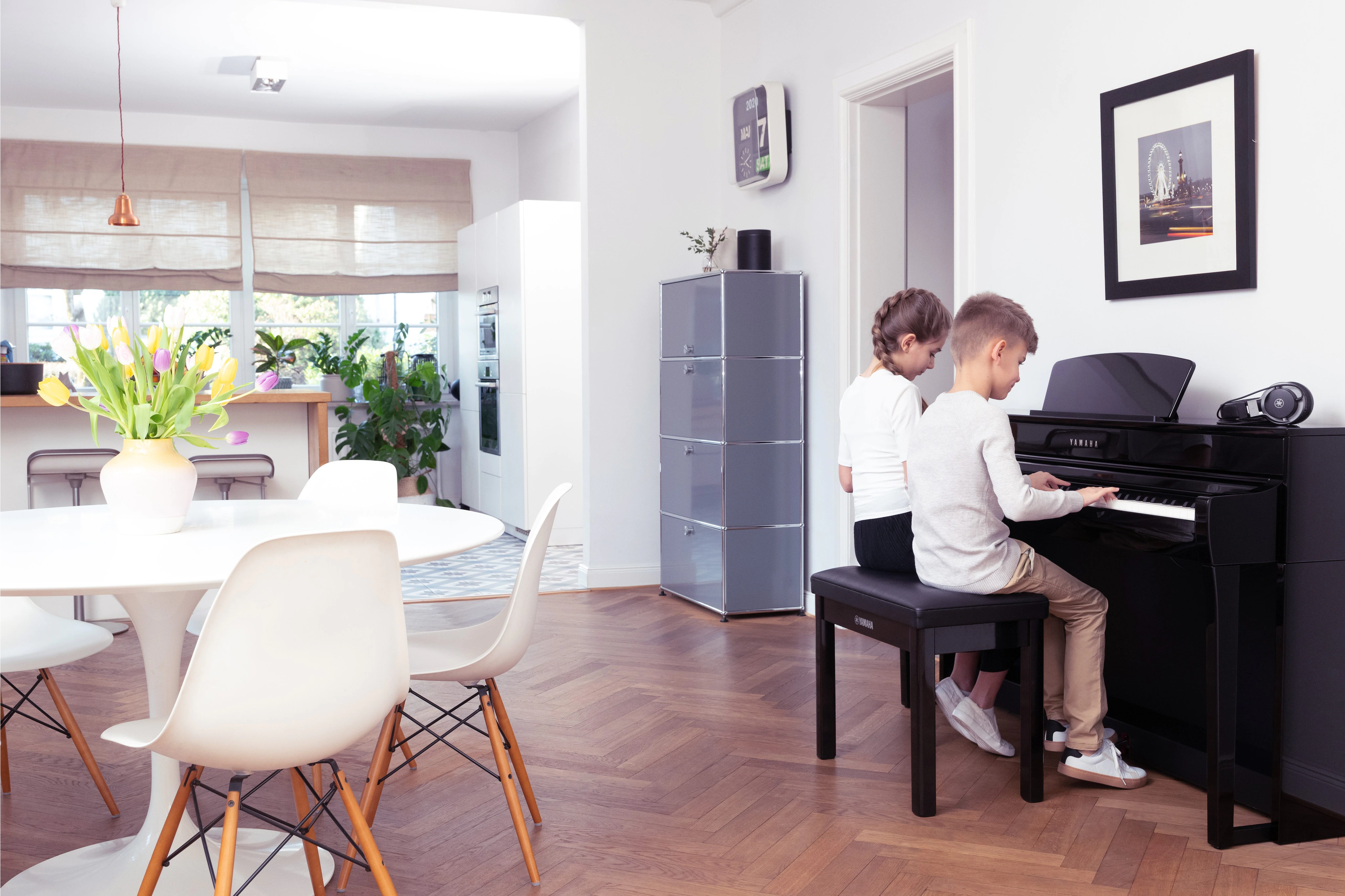 Yamaha CLP-735 offers a dynamic range of piano mechanics, a realistic response to every gentle touch, wooden keys, a simple control panel and the ability to play songs via Bluetooth.
Yamaha CLP-735 offers a dynamic range of piano mechanics, a realistic response to every gentle touch, wooden keys, a simple control panel and the ability to play songs via Bluetooth.
Digital piano for beginner of any age
First, the digital piano must have everything that can replace an acoustic piano, its sound and the playing experience. There is no other guarantee that a beginner will not acquire faulty playing habits. Let us focus on models, which keyboards mimic the dynamics of an acoustic keyboard, i.e. different key resistance at different level the key is being depressed.
It must sound like an acoustic piano
Each brand uses its own technologies to adapt the key response as closely to the acoustic piano as possible. We will discuss the dynamics of the keyboard later. If the instrument has a keyboard with dynamic keys, the player will gain a good foundation and ability to play any other piano in the future.
Rather dynamics and pedals than heaps of unnecessary functions
A beginner will not be able to immediately utilize all the functions that the electronic piano offers. While choosing a digital piano, we should especially focus on the quality of the keyboard and the overall ease of use. The piano equipment must also include pedals. Their purpose while playing is not just to add variety, but is often a necessity in the interpretation of many works and even has a special symbol reserved in the sheet music, so the player knows when to use the pedal. If we come across a model that does not have a built-in pedal unit directly in the base of the piano, we should buy external keyboard pedals.
What are the keyboard pedals for
The standard equipment of the built-in keyboard pedal unit is the sustain pedal (also referred to as damper pedal), sostenuto pedal and soft pedal.
Soft pedal
Soft pedal softens the sounds. The resulting sound is subdued, quieter and less crisp.
Sostenuto pedal
The Sostenuto pedal has a similar function as the sustain pedal, and they are often mistaken by beginners. The difference is that the sustain pedal prolongs the sound of all the tones that are currently being heard, and the sostenuto pedal only prolongs the duration of those tones that were heard before it was pressed.
Sustain pedal
The sustain pedal extends the tone. Higher quality models enable to use a sustain pedal with a half pedal function. Thanks to this sophisticated feature, the pedal is not limited to only two basic positions, but it can also respond dynamically to the intensity at which we step on it.
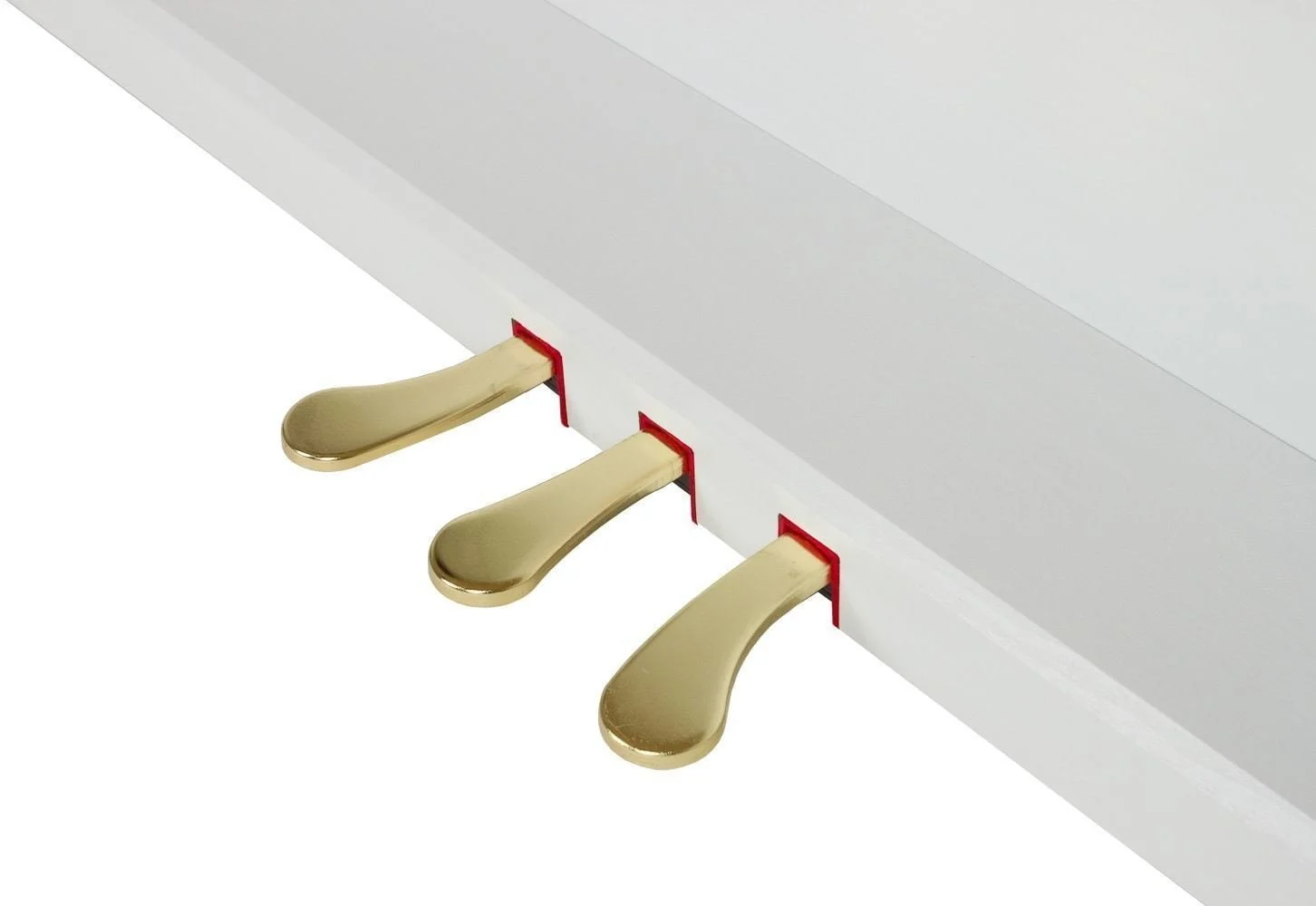 If the piano does come with the built-in pedals, they should be purchased separately. The standard pedal unit looks like this: on the far left is a soft pedal that softens the tone. In the middle is a sostenuto pedal that extends the sound of all tones. To the right is a sustain pedal that extends the sound of the tones currently being played.
If the piano does come with the built-in pedals, they should be purchased separately. The standard pedal unit looks like this: on the far left is a soft pedal that softens the tone. In the middle is a sostenuto pedal that extends the sound of all tones. To the right is a sustain pedal that extends the sound of the tones currently being played.
Metronome
The piano for beginners should have a built-in metronome that helps to get the right sense of tempo and is easy to use. Experts recommend starting to use the metronome in parallel with the first tones learned. Thanks to metronome, the beginner will establish an internal rhythm clock, learn to perceive the tempo and rhythm of the composition and improve his/hers technique. Superior digital pianos have a built-in metronome that is easy to operate. Both the number of beats per minute (BPM) and the volume of the click can be adjusted.
The learning app can be for free
A great added value for a beginner can also be a high-quality built-in teaching program, or an app for smart devices, which allows the player to follow his/hers favourite songs or guide him/her in a well readable sheet and show which tone in the song will come next. Renowned brands offer various apps for free. The selection of apps is vast, but we have been satisfied with flowkey or Skoove apps the most.
 Skoove can show by which finger you should play the exact note. Notes and fingering are displayed at a slow pace, and the app can also listen and point out possible errors in real time. You can choose a favourite song to practice from the rich menu. The app is easy to use and can be handled by children from about 12 years of age.
Skoove can show by which finger you should play the exact note. Notes and fingering are displayed at a slow pace, and the app can also listen and point out possible errors in real time. You can choose a favourite song to practice from the rich menu. The app is easy to use and can be handled by children from about 12 years of age.
Digital piano for advanced creative players
We should pay extra attention if we are picking the electric piano for an intermediate or advanced player as an instrument for performing in the band or for playing modern music styles based on genres such as rock, pop or jazz.
Massive home models
Let's take a look at digital pianos which have a proper production station "under the hood" and offer numerous advanced functions, and let us also choose according to the type of construction. Should the piano serve as a standard home piano, or will it often be carried from place to place?
Most models of standard home pianos have a massive cabinet attached to a wooden base with a closed back. They usually weigh around 40 kg, but some models can weigh about 100 kg, so frequent transport is out of the question. It is a sturdy piece of furniture that can also impress by its design.
Let's take a look at digital pianos which have a proper production station "under the hood" and offer numerous advanced functions, and let us also choose according to the type of construction. Should the piano serve as a standard home piano, or will it often be carried from place to place?
Most models of standard home pianos have a massive cabinet attached to a wooden base with a closed back. They usually weigh around 40 kg, but some models can weigh about 100 kg, so frequent transport is out of the question. It is a sturdy piece of furniture that can also impress by its design.
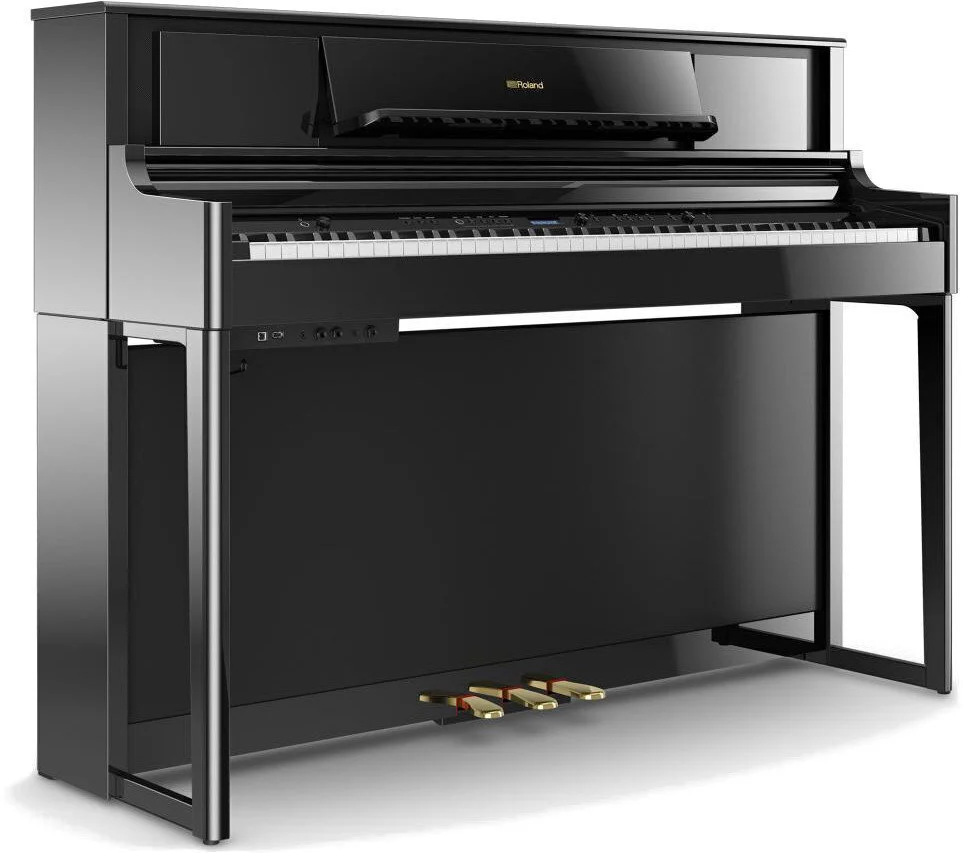 Roland LX705: a typical massive home piano. Unlimited polyphony and a number of modern functions allow you to push the limits of your creativity.
Roland LX705: a typical massive home piano. Unlimited polyphony and a number of modern functions allow you to push the limits of your creativity.
Lightweight or portable models
There are also lightweight models, which are firmly attached to the wooden base, but they are more compact, do not have a filled back and thanks to the much lower weight, they are easy to move. A different chapter are the portable models, which do not have a solid base and their compact dimensions and appearance resemble keyboards rather than pianos, but they lack nothing equipment-wise.
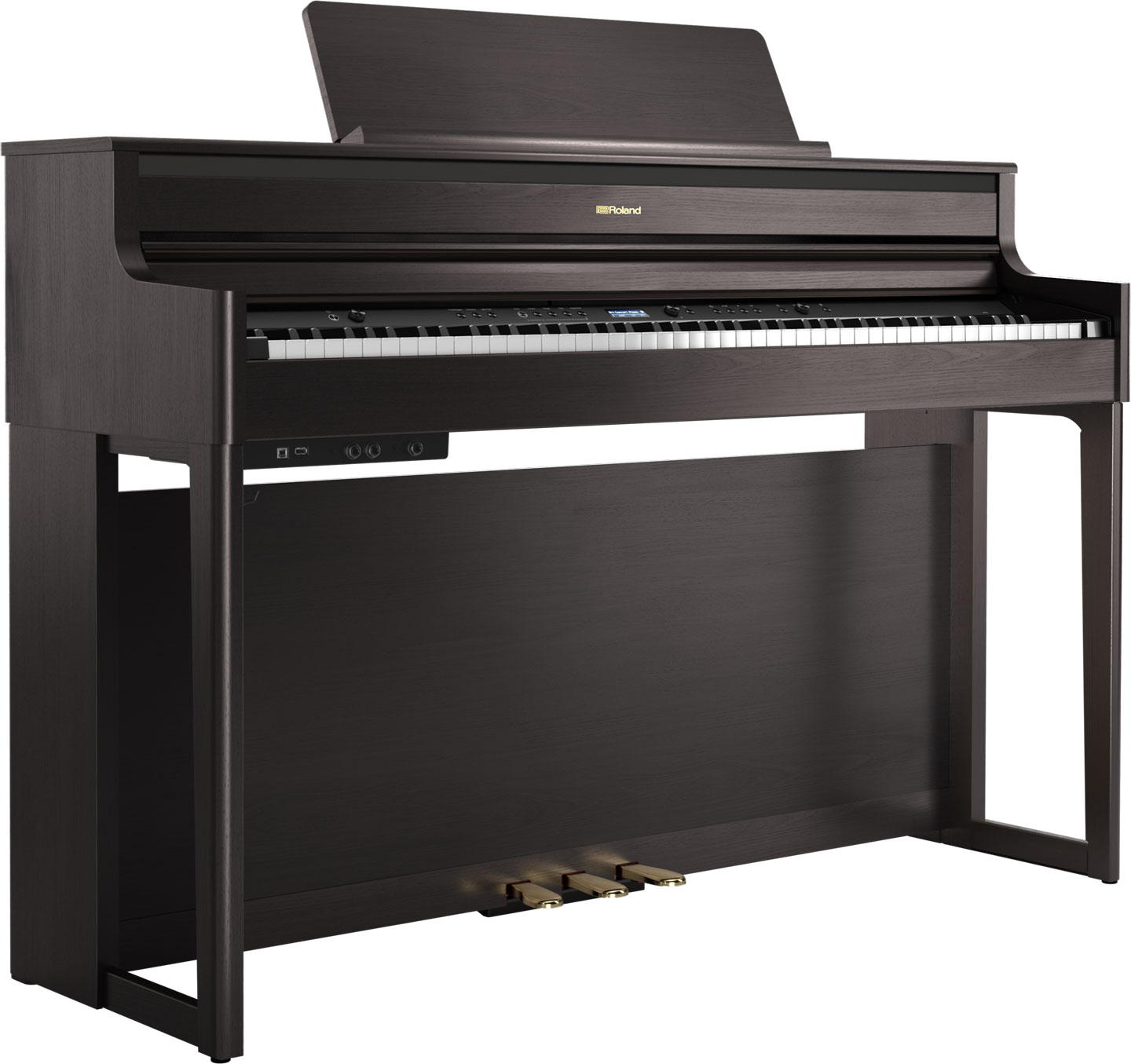 Roland HP704: Piano with semi-opened back offers a huge collection of sounds and features.
Roland HP704: Piano with semi-opened back offers a huge collection of sounds and features.
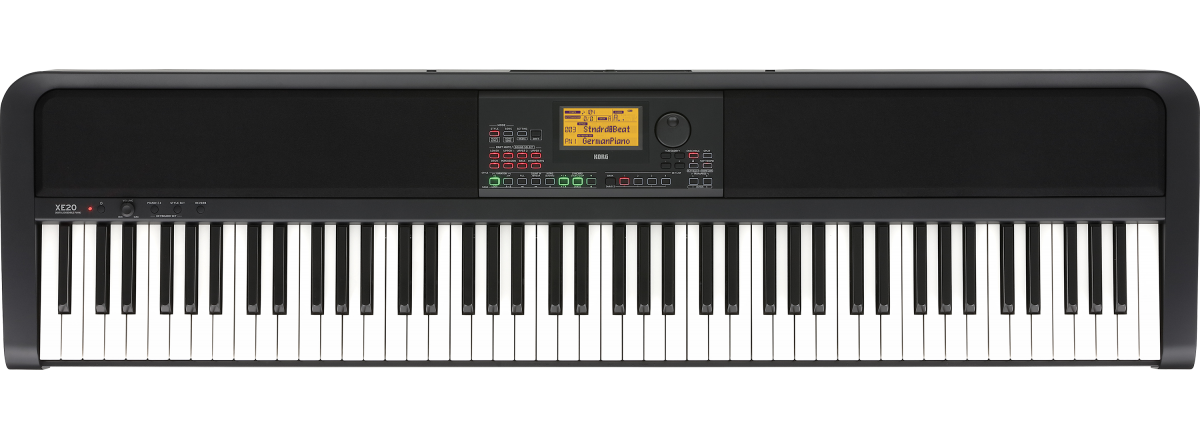 Korg XE20: This hybrid model, loaded with quality sounds and features, comes as a portable piano as well as a compact piano with an elegant stand.
Korg XE20: This hybrid model, loaded with quality sounds and features, comes as a portable piano as well as a compact piano with an elegant stand.
Experiments and recording
More advanced players will certainly appreciate the automatic accompaniment feature, which can also be found in keyboards. The offer and the range of quality of the built-in rhythms, which you can accompany by your own playing, is truly ample. The creative advanced player has covered the basics long time ago and is interested in experimenting with sound and creating his own compositions. The recording function will therefore be beneficial. The capacity and quality of the recorder varies greatly from model to model. Basic models can save only one song, premium brands can save multiple songs and allow you to record the play of each left and right hand on separate tracks.
Give the sound space and style
The popular function of combining sounds (called Layer or Dual) will also find creative use, as it allows adding the sound of another instrument from the database on top of the sound of primary played piano. Sound based on organ, synthesizer or string instruments, for example, can create a very interesting spatial backdrop. It can also be modified by adding various effects, most often we find built-in effects such as hall, chorus, phaser, tremolo, room. Many portable models would also fit into the stage piano category thanks to their engaging creative features. Sometimes it is hard to draw a line between what is still considered a digital piano and what is a stage piano.
Digital grand pianos of premium quality
This is a real crème de la crème among digital instruments. They refer to acoustic concert grand pianos with their peculiar elegant shape and state-of-the-art keyboard. These instruments offer sound samples of the world's best concert pianos recorded in high quality with exceptionally rich distinction of all details. The sound simulation of respected acoustic pianos in the most famous concert halls worldwide is excellent.
Digital grand pianos utilize sophisticated technologies to mimic the powerful reverberations typical of acoustic instruments, which are generated by the resonance throughout the body of the instrument. The top lid can be opened to make the sound louder, just like on the acoustic grand pianos.
Top quality costs, and their price is significantly higher than the price of standard digital pianos. These design masterpieces are simply not meant for everyone, however, when these chic and elegant pieces shine in a generous interior, the look and sound are really worth it!
Most essential parameters in detail
The most important feature of a digital piano is the capability to more or less realistically imitate the sound and the feel of playing typical of an acoustic piano. Let us focus on sound, keyboard and polyphony.
Sound
The sound of a digital piano is based on digitized samples of real acoustic pianos
Each manufacturer takes a different approach to emulate the sound of an acoustic piano.
The most important is how closely the piano can simulate the sound of an acoustic piano.
Some models offer an ample collection of sounds, which is OK, but we have to consider what we will actually utilize while playing.
The sound of a digital piano is the result of the imitation of individual samples, which originate from recordings of real concert pianos and grand pianos.
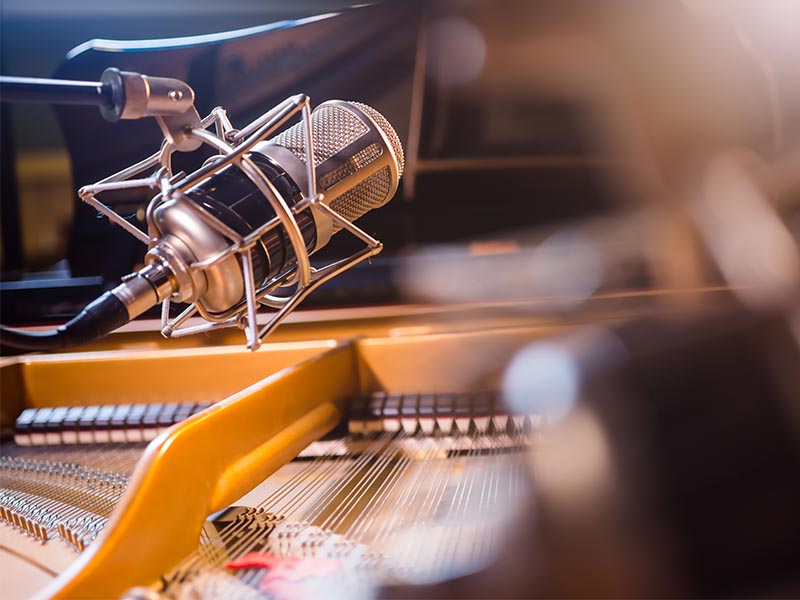 The sound of a digital piano is based on digitized samples of real acoustic pianos
The sound of a digital piano is based on digitized samples of real acoustic pianos
However, some rather basic models do not have every key sampled by the sound of an acoustic piano, but only every third, for example. Unsampled tones are then only the result of derived transposition of sampled tones.
It can be exposed by unnatural rebounds or different tone colouration if we listen carefully enough. Moreover, we should also pay attention that individual tones do not sound sterile. In the natural environment of an acoustic piano, the played tone would always be accompanied by a secondary sound or a slight resonance of the string.
It is common that the adjacent tone or a tone from a higher frequency spectrum appears while playing on the acoustic piano. All of these side sounds are natural, so they should also be encompassed in the sampled digital piano sounds. It depends on how the technology used by each manufacturer or model can meet this challenge. Brands like Kurzweil, Yamaha, Roland and Korg are traditionally an assurance of a realistic sound.
Keyboard
The way the keyboard is made, the balance of the keys and their coating, have a major impact on the overall experience of playing.
The term balanced keyboard refers to the ability of the keys to respond dynamically to pressing.
Since digital pianos do not possess the traditional mechanics of a hammer hitting the string, they must apply a sophisticated way of balancing the keys to be able to imitate the features and experience of playing an acoustic piano.
Although a hammer is also a part of the digital piano's mechanics, it does not produce a tone, but it serves only as a counterweight to the key when pressed. In the case of a digital piano, the tone itself is created by using electronic sensors.
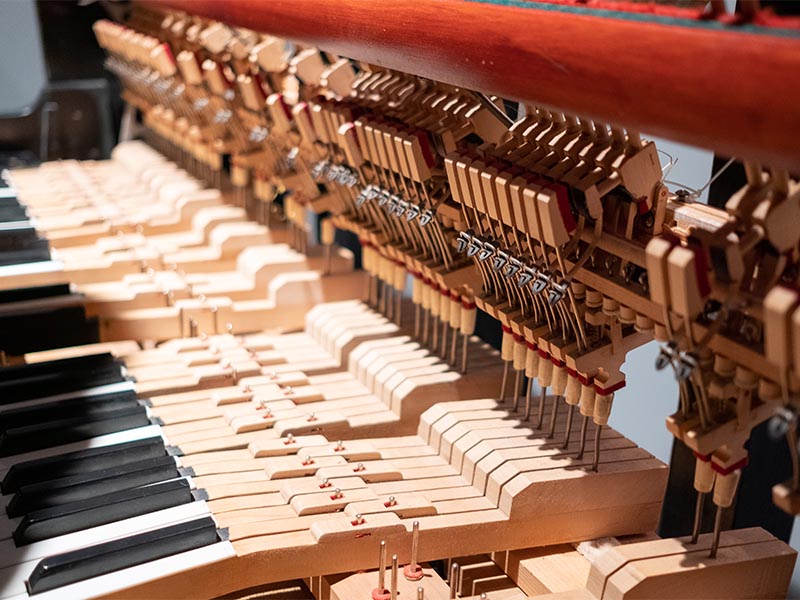 Detail of the hammer-action mechanics of an acoustic piano
Detail of the hammer-action mechanics of an acoustic piano
The balanced keyboard thus simulates the resistance and response of the keys of a traditional hammer-action mechanism. Manufacturers of digital pianos also had to deal with another typical feature of acoustic pianos – the hammers of bass keys are heavier than the hammers of tones in higher positions. Digital piano designers have therefore come up with the idea of some kind of scaled or tiered key balance.
Each brand develops its own technology to imitate the hammer-action mechanics of an acoustic piano. Therefore, they call their solutions of key balancing differently: Korg: Real Weighted Hammer Action, Yamaha: Graded Hammer, Roland: Progressive Hammer, Kurzweil: Graded Hammer Action or Casio: Scaled Hammer Action.
Polyphony
Polyphony consists not only of tones played with fingers, but also tones of background sound or sustain pedal. 128-tone polyphony will therefore run out fairly quickly.
This crucial parameter indicates how many sounds can be played on the piano at the same time.
A piano with a higher polyphony value allows the user to play more complex melodies without omitting any notes.
Besides the tones we play with our fingers, we have to count into the resulting sound also all the tones that are heard when, for example, we press the sustain pedal.
If the digital piano has a capacity lower than 128-tone polyphony, we will reach its limit easily. Tones that would no longer fit into the limit are simply removed from the resulting sound by the piano.
 Polyphony consists not only of tones played with fingers, but also tones of background sound or sustain pedal. 128-tone polyphony will therefore run out fairly quickly.
Polyphony consists not only of tones played with fingers, but also tones of background sound or sustain pedal. 128-tone polyphony will therefore run out fairly quickly.
The digital piano we are choosing should have at least 128-tone polyphony, the top quality pianos offer up to 256 to 384 notes, or even unlimited polyphony.
Accessories
In the package of a digital piano or stage piano you will find everything you need. Just unbox, plug and play. Nowadays, all digital pianos have a built-in audio system and the package also includes a power adapter by default. Make sure that the model you are looking for also contains pedals that you will need in due time. In addition to basic accessories, a stool is helpful, as well as headphones. An attractive choice is a bundle of the instrument and accessories, which offers not only a digital piano but also headphones, stool and other practical equipment at reduced price.
Care and maintenance
While every acoustic piano gets out of tune over the time and a professional tuner is necessary for tuning, this will never be a case with a digital instrument. When looking for a suitable space to place it, it is necessary to keep in mind that it has mostly a wooden structure, so we should not put it close to an open fire, fireplace or chimney.
Keyboard and pedals
How should we do a regular maintenance and care? The most vulnerable part of the piano is the electronics and the keyboard. We always have to cover the keyboard. If the piano does not include protective fallboard, we should get a suitable size key dust cover. We get rid of the dust regularly, the most practical is an ordinary anti-static household duster. We can also carefully wash the keys with a clean water-dampened cloth, but we must be meticulous not to let water to get between the keys. Likewise, we clean the pedals the same way.

- Dust cover
- Common anti-static duster
- Cloth
- Clean water
Cabinet
To remove dust and dirt from the cabinet, we use a cloth and a bit of window cleaner. We should not apply this to models that have a construction made of real wood. It is preferable to use a special care product for the specific type of the wood.

- Window cleaner (models made of synthetic material)
- Wood care product (only for models made of wood)
- Cloth
Low failure rate
From our own experience, we know that reputable brands of electric pianos have only a very low failure rate. However, if a fault occurs anyway, we recommend you to entrust it to the specialist. In case you will have to file a warranty claim, you should definitely reach out to our Claim Center, which will find an effective solution.
 Guitars
Guitars


 Microphones
Microphones

 Lighting
Lighting

 Traditional
Traditional Strings
Strings Winds
Winds


 Headphones
Headphones Audio
Audio













